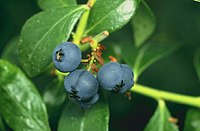
Effects of a foliar spray of selenite or selenate at different growth stages on selenium distribution and quality of blueberries.
Sign Up to like & getrecommendations! Published in 2018 at "Journal of the science of food and agriculture"
DOI: 10.1002/jsfa.9004
Abstract: BACKGROUND Foliar spraying of selenium (Se) has increasingly been applied to improve Se concentrations in grain crops, although little information is available about the properties of Se-enriched fruits. In the present study, selenium distribution in… read more here.
Keywords: quality; fruit; blueberry; selenite selenate ... See more keywords

Effects of selenite and selenate application on distribution and transformation of selenium fractions in soil and its bioavailability for wheat (Triticum aestivum L.)
Sign Up to like & getrecommendations! Published in 2017 at "Environmental Science and Pollution Research"
DOI: 10.1007/s11356-017-8512-9
Abstract: This study investigated the effect of selenate and selenite application on the distribution, transformation of selenium (Se) fractions in soil, as well as the accumulation and availability of Se in each part of wheat plants.… read more here.
Keywords: wheat; control; selenate; selenite selenate ... See more keywords

Simultaneous Removal of Selenite and Selenate by Nanosized Zerovalent Iron in Anoxic Systems: The Overlooked Role of Selenite.
Sign Up to like & getrecommendations! Published in 2021 at "Environmental science & technology"
DOI: 10.1021/acs.est.0c08142
Abstract: The application of nanosized zerovalent iron (nZVI) for reductive immobilization of selenite (Se(IV)) or selenate (Se(VI)) alone has been extensively investigated. However, as the predominant species, Se(IV) and Se(VI) usually coexist in the environment. Thus,… read more here.
Keywords: zerovalent iron; removal; nanosized zerovalent; selenite selenate ... See more keywords

Sequestration of Selenite and Selenate in Gypsum (CaSO4·2H2O): Insights from the Single-Crystal Electron Paramagnetic Resonance Spectroscopy and Synchrotron X-ray Absorption Spectroscopy Study
Sign Up to like & getrecommendations! Published in 2020 at "Environmental Science & Technology"
DOI: 10.1021/acs.est.9b05714
Abstract: Gypsum is the most common sulfate mineral on Earth's surface and is the dominant solid byproduct in a wide variety of mining and industrial processes, thus representing a major source for heavy metal(loid) contamination, including… read more here.
Keywords: selenite selenate; spectroscopy; ray absorption; gypsum ... See more keywords

Selenium uptake and bio-transformation in Brassica rapa supplied with selenite and selenate: A hydroponic work with HPLC speciation and RNA-sequencing.
Sign Up to like & getrecommendations! Published in 2019 at "Journal of agricultural and food chemistry"
DOI: 10.1021/acs.jafc.9b05359
Abstract: Vegetables are an ideal source of human Se intake; it is important to understand selenium (Se) speciation in plants due to the distinct biological functions of selenocompounds. In this hydroponic study, the accumulation and assimilation… read more here.
Keywords: brassica rapa; speciation rna; hplc speciation; selenite selenate ... See more keywords

Direct and indirect selenium speciation in biofortified wheat: a tale of two techniques.
Sign Up to like & getrecommendations! Published in 2022 at "Physiologia plantarum"
DOI: 10.1111/ppl.13843
Abstract: Wheat can be biofortified with different inorganic selenium (Se) forms, selenite or selenate. The choice of Se source influences the physiological response of the plant and the Se metabolites produced. We looked at selenium uptake,… read more here.
Keywords: selenite selenate; indirect selenium; direct indirect; speciation ... See more keywords

Adsorption of Selenite and Selenate on Ferrihydrite in the Presence and Absence of Dissolved Organic Carbon.
Sign Up to like & getrecommendations! Published in 2018 at "Journal of environmental quality"
DOI: 10.2134/jeq2017.09.0352
Abstract: This study examines selenite [Se(IV)] and selenate [Se(VI)] adsorption on two-line ferrihydrite in the presence and absence of two low-molecular-weight dissolved organic carbon (DOC) species, citric and salicylic acid. Ferrihydrite surface potential measurements were also… read more here.
Keywords: adsorption; salicylic acid; presence; sorption ... See more keywords

Selenium Accumulation Characteristics and Biofortification Potentiality in Turnip (Brassica rapa var. rapa) Supplied with Selenite or Selenate
Sign Up to like & getrecommendations! Published in 2018 at "Frontiers in Plant Science"
DOI: 10.3389/fpls.2017.02207
Abstract: Selenium (Se) is an essential trace element for humans. About 70% of the regions in China, including most of the Tibetan Plateau, are faced with Se deficiency problems. Turnip is mainly distributed around the Tibetan… read more here.
Keywords: rapa; selenium accumulation; selenite selenate; biofortification ... See more keywords